精心整理 外研版小学英语(新标准一起)一年级下册M4教学设计
- 格式:pdf
- 大小:2.55 MB
- 文档页数:15

一年级下英语教案-Module 4 Unit 2 These are your legs-外研社(一起)一、教学目标1. 语言知识目标1.能听懂并掌握单词legs, feet, hands, arms。
2.能理解句型These are your …。
3.能用英语描述自己和他人的身体部位。
2. 情感态度价值观目标1.学生了解并认识自己的身体局部。
2.学生了解并尊重他人的身体局部。
二、教学重难点1.能听懂并掌握单词legs, feet, hands, arms。
2.能理解句型These are your …。
三、教学过程1. Warm-up1.Greeting: Good morning/afternoon, boys and girls! (播放背景音乐)2.Revision: Review the vocabulary of body parts – head, nose, mouth, ears.2. Presentation1.Show a picture of a human body and point at different parts of the body while asking students to repeat after you.2.Introduce the new vocabulary words by showing pictures and saying the words. Repeat with the whole class together.3. Practice1.Show a picture of a child and ask students to identify thedifferent parts of the body.2.Play a game of Simon says, using the new vocabulary (e.g. Simon says, “touch your hands”, etc.)e flashcards to drill the vocabulary words.4. Production1.Ask students to stand up and touch different parts of their body as you name them.2.Divide the class into pairs or groups. Students take turns asking their partner/group member “What are these?” referring to different parts of their body.3.Students can describe their own body parts using the sentence structure “These are …”5. Extension1.Play a game of “I Spy” using t he new vocabulary words.2.Sing a song about body parts such as “Head, shoulders, knees and toes”.四、Homework1.Students should draw and label a picture of a person, identifying different body parts (as many as they can remember from today’s class).2.Students should practice using the vocabulary words with their family members at home.五、教学反思本节课主要通过图片、游戏和互动的形式,使学生掌握身体部位的单词及句型These are your … 。
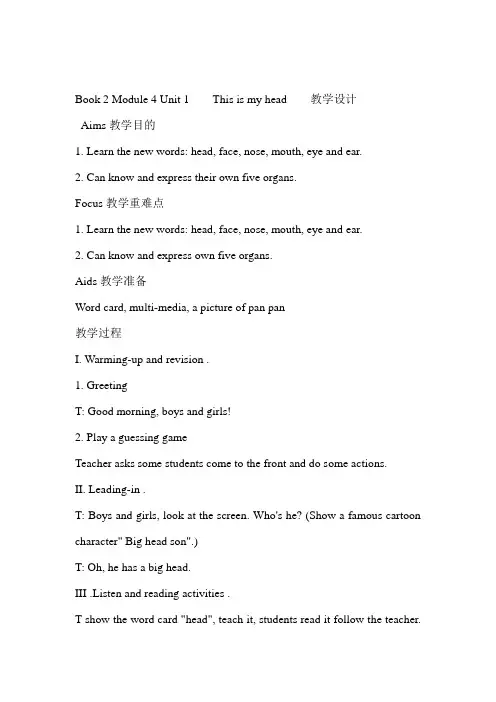
Book 2 Module 4 Unit 1 This is my head 教学设计Aims教学目的1. Learn the new words: head, face, nose, mouth, eye and ear.2. Can know and express their own five organs.Focus教学重难点1. Learn the new words: head, face, nose, mouth, eye and ear.2. Can know and express own five organs.Aids教学准备Word card, multi-media, a picture of pan pan教学过程I. Warming-up and revision .1. GreetingT: Good morning, boys and girls!2. Play a guessing gameTeacher asks some students come to the front and do some actions.II. Leading-in .T: Boys and girls, look at the screen. Who's he? (Show a famous cartoon character" Big head son".)T: Oh, he has a big head.III .Listen and reading activities .T show the word card "head", teach it, students read it follow the teacher.Teacher must emphasize "ea" pronounces as /e/.Compare "hand" with "head".2)T: Oh, it's seven o'clock in the morning! I must wake up. (T does the action as wash face)T: Boys and girls, what am I doing?T: I am washing my face.T show the word card "face", teach it, students read it follow the teacher. Teacher must emphasize "ac" pronounces as /ei/.3) T: What's this? (Show a picture of a toy elephant at the screen)T: Yes, you're right. Elephant has a long nose.T show the word card "nose", teach it, students read it follow the teacher. Teacher must emphasize "nose" pronounces as /nauz/.4T: What's under the nose? (T touch the nose)T: It's mouth.T show the word card "mouth", teach it, students read it follow the teacher. Teacher must emphasize "ou" pronounces as /au/.T: This your mouth (Point at the students)5) T: Boys and girls, let's play another guessing game. They are two twins brothers. But they didn't see each other any day.We use them listen something. Guess, what are they?T: Yes, they're ears.T show the word card "ear", teach it, students read it follow the teacher.Teacher must emphasize the pronunciation.T: This is your ear. (Point at the students)6) T: What other organs in our face?T: Yes, they're our eyes.T show the word card "eye", teach it, students read it follow the teacher. Teacher must emphasize the pronunciation.T: This is your eye. (Point at the students)IV. Further development1) Play a game: Touch your mouth/face/head/nose/eye/ear.Ask some students come to the front do the action, other students give the orders:2) T: Boys and girls, my name's pan pan. This is the picture of me. Look, this is my mouth/face/head/nose/eye/ear. (T acts as pan pan).Ⅵ. Assign the homework.S:Good morning,Miss Qin!other student guess" what is his/her occupation?" when they know the answer, they must hands up and say He's/She's a...S: .....Do the actions "Touch your head".Ss: This is my head.S: ...Do the actions" Touch your face".Ss: This is my faceS: It's an elephant.Do the actions" Touch your nose".Ss: This is my nose.S: ...Do the actions" Touch your mouth".Ss: This is my mouth.S: ...Do the actions" Touch your ear/ears".Ss: This is my ear.S: ...Do the actions" Touch your eye/eyes".Ss: This is my eye.Do the action.someone come to the front draw a picture of themselves.。
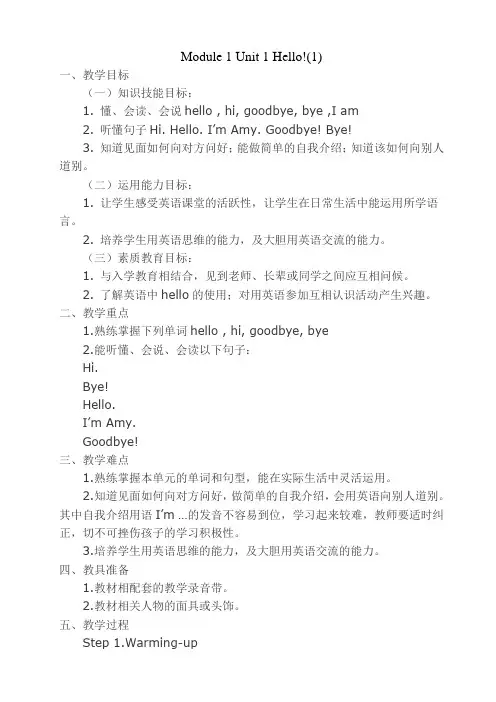
Module 1 Unit 1 Hello!(1)一、教学目标(一)知识技能目标:1. 懂、会读、会说hello , hi, goodbye, bye ,I am2. 听懂句子Hi. Hello. I’m Amy. Goodbye! Bye!3. 知道见面如何向对方问好;能做简单的自我介绍;知道该如何向别人道别。
(二)运用能力目标:1. 让学生感受英语课堂的活跃性,让学生在日常生活中能运用所学语言。
2. 培养学生用英语思维的能力,及大胆用英语交流的能力。
(三)素质教育目标:1. 与入学教育相结合,见到老师、长辈或同学之间应互相问候。
2. 了解英语中hello的使用;对用英语参加互相认识活动产生兴趣。
二、教学重点1.熟练掌握下列单词hello , hi, goodbye, bye2.能听懂、会说、会读以下句子:Hi.Bye!Hello.I’m Amy.Goodbye!三、教学难点1.熟练掌握本单元的单词和句型,能在实际生活中灵活运用。
2.知道见面如何向对方问好,做简单的自我介绍,会用英语向别人道别。
其中自我介绍用语I’m …的发音不容易到位,学习起来较难,教师要适时纠正,切不可挫伤孩子的学习积极性。
3.培养学生用英语思维的能力,及大胆用英语交流的能力。
四、教具准备1.教材相配套的教学录音带。
2.教材相关人物的面具或头饰。
五、教学过程Step 1.Warming-upT:同学们,大家肯定都喜欢看卡通动画片吧!可是你们知道吗,“卡通”一词的发音是由英语单词Cartoon一词的发音直接翻译过来的。
在现实生活中,我们还有许多这样的情况,有时我们甚至直接用英语的几个字母来代表一种物品,如CD, VCD, DVD等等。
(设计说明:由于学生是第一次正式接受英语课的学习,教师可以采取交谈的方式与学生讨论一下英语的作用以及学习英语的意义。
让学生说说他们在现实生活中已经了解的英语单词或日常交际用语,例如用学生熟悉的CD, VCD, DVD, OK! Hi! Yeah! Wow! Bye! E-mail, Cartoon等词来激发学生学习兴趣与学习愿望。
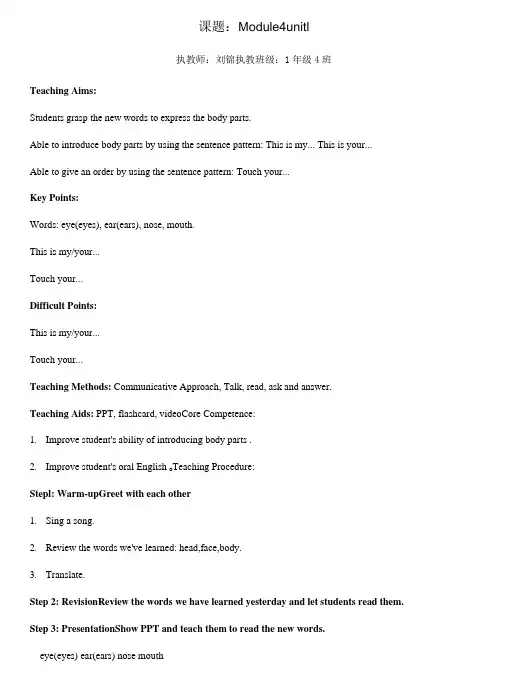
课题:Module4unitl执教师:刘锦执教班级:1年级4班Teaching Aims:Students grasp the new words to express the body parts.Able to introduce body parts by using the sentence pattern: This is my... This is your...Able to give an order by using the sentence pattern: Touch your...Key Points:Words: eye(eyes), ear(ears), nose, mouth.This is my/your...Touch your...Difficult Points:This is my/your...Touch your...Teaching Methods: Communicative Approach, Talk, read, ask and answer.Teaching Aids: PPT, flashcard, videoCore Competence:1.Improve student's ability of introducing body parts .2.Improve student's oral English o Teaching Procedure:Stepl: Warm-upGreet with each other1.Sing a song.2.Review the words we've learned: head,face,body.3.Translate.Step 2: RevisionReview the words we have learned yesterday and let students read them. Step 3: PresentationShow PPT and teach them to read the new words.eye(eyes) ear(ears) nose mouthRead the words together.1.Ask students to come in the front and show the others the word cards. And then ask the others to give anorder by using the sentence pattern: Touch your...,and the four students do the action.2.Teach the new contents by using the sentence patterns: This is my/your ...When I say: This is my..., you should point and say: This is your...When I say: This is your..., you should touch and say: This is your...3.Invite some pairs to come in the front to point and say :This is my... and This is your...4.Game:T says: This is Xiaomei. This is Xiaoshuai. Their five sense organs are missing. Where are they? It's in my envelopes. We should put them back on their faces.Divide them into 4 groups and then choose six students from each group to put the missing parts on Xiaomei/ Xiaoshuai's face one by one. When they finish, they should point and say: This is your... and This is my...Step 4: PracticeClap and say.1.Rising tone and falling tone.2.Practice group by group.3.High or low voice.4.I say you do by using the sentence pattern: Touch your...5.Game: What's miss?6.Point and say by using the sentence: This is my...7.Work in pairs by practising the sentence pattern: This is my/your...8.Game: put the missing parts on baby's face by practising the sentence pattern: This is my/your...9.Listen and repeat.Step 5: DrillsChoose four students from each group to come in the front and show the word cards to the others. And then let the others to give an order by using the sentence pattern: Touch your... The four students should do the action. The winner can get a star for their group.1.Practice the sentence pattern: This is my/your ...When I say: This is my..., you should point and say: This is your...When I say: This is your..., you should touch and say: This is your...some pairs to come in the front to point and say :This is my... and This is your.4. Choose six students from each group, and the let them put the missing parts on baby's face one by one by practising the sentence pattern: This is my/your...Step 6: SummaryRead the text together.Step 7: HomeworkPractice with your partner by using the sentence pattern: This is my/ your...Blackboard Design:Module4 Unitl This is my head.Group 1:eye eyes ear ears nose mouthTouch your... This is my... This is your...Teaching Reflection:本节课是以词汇和简单句型的学习为基础,由歌曲引出学习内容,引出本课的标题:This is my head. 即在在本节课的教学中主要让学生学习介绍身体结构,并且能够熟练使用祈使句。
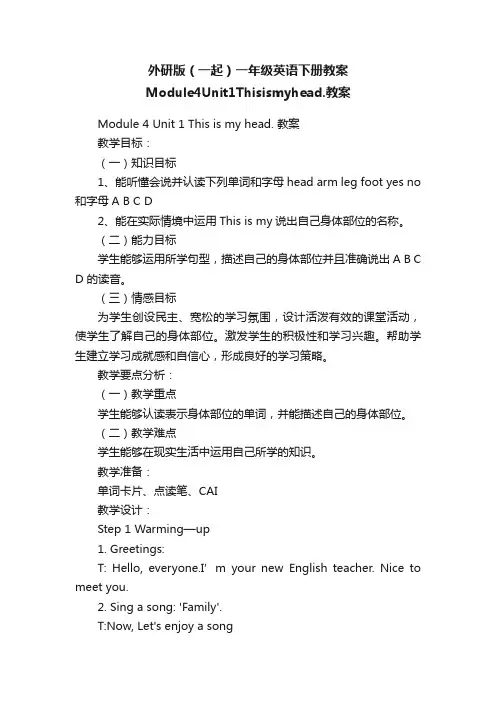
外研版(一起)一年级英语下册教案Module4Unit1Thisismyhead.教案Module 4 Unit 1 This is my head. 教案教学目标:(一)知识目标1、能听懂会说并认读下列单词和字母head arm leg foot yes no 和字母A B C D2、能在实际情境中运用This is my说出自己身体部位的名称。
(二)能力目标学生能够运用所学句型,描述自己的身体部位并且准确说出A B C D 的读音。
(三)情感目标为学生创设民主、宽松的学习氛围,设计活泼有效的课堂活动,使学生了解自己的身体部位。
激发学生的积极性和学习兴趣。
帮助学生建立学习成就感和自信心,形成良好的学习策略。
教学要点分析:(一)教学重点学生能够认读表示身体部位的单词,并能描述自己的身体部位。
(二)教学难点学生能够在现实生活中运用自己所学的知识。
教学准备:单词卡片、点读笔、CAI教学设计:Step 1 Warming—up1. Greetings:T: Hello, everyone.I’m your new English teacher. Nice to meet you.2. Sing a song: 'Family'.T:Now, Let's enjoy a song3.ReviewT/S:Now,I’m Jenny.This is my mother/father/brother/sister.(教师戴头饰引导学生复习) 【设计意图】利用以前学过的问候语师生问好,让学生养成运用英语的习惯。
通过热身活动让学生动起来,活跃课堂气氛,激发学生的学习热情和兴趣。
Step 2 Presentation and Text study1.Listen and answerT:Jenny is our friend. Do you want to know what is Jenny doing? Let's listen.(她在干什么?) 放第一遍动画。
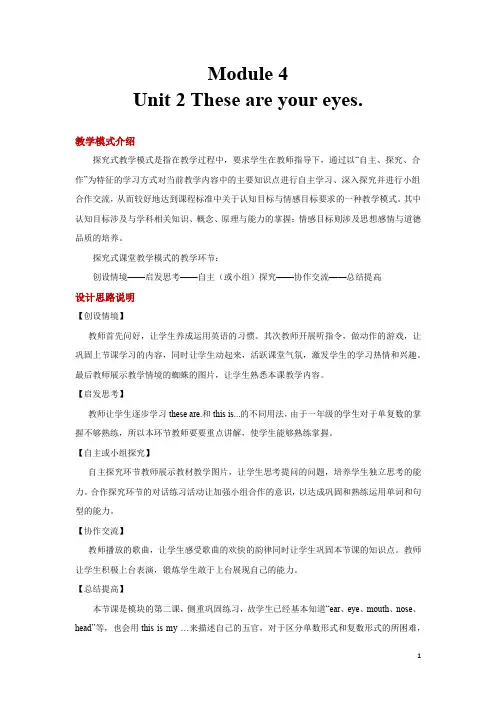
Module 4Unit 2 These are your eyes.教学模式介绍探究式教学模式是指在教学过程中,要求学生在教师指导下,通过以“自主、探究、合作”为特征的学习方式对当前教学内容中的主要知识点进行自主学习、深入探究并进行小组合作交流,从而较好地达到课程标准中关于认知目标与情感目标要求的一种教学模式。
其中认知目标涉及与学科相关知识、概念、原理与能力的掌握;情感目标则涉及思想感情与道德品质的培养。
探究式课堂教学模式的教学环节:创设情境——启发思考——自主(或小组)探究——协作交流——总结提高设计思路说明【创设情境】教师首先问好,让学生养成运用英语的习惯。
其次教师开展听指令,做动作的游戏,让巩固上节课学习的内容,同时让学生动起来,活跃课堂气氛,激发学生的学习热情和兴趣。
最后教师展示教学情境的蜘蛛的图片,让学生熟悉本课教学内容。
【启发思考】教师让学生逐步学习these are.和this is...的不同用法,由于一年级的学生对于单复数的掌握不够熟练,所以本环节教师要要重点讲解,使学生能够熟练掌握。
【自主或小组探究】自主探究环节教师展示教材教学图片,让学生思考提问的问题,培养学生独立思考的能力。
合作探究环节的对话练习活动让加强小组合作的意识,以达成巩固和熟练运用单词和句型的能力。
【协作交流】教师播放的歌曲,让学生感受歌曲的欢快的韵律同时让学生巩固本节课的知识点。
教师让学生积极上台表演,锻炼学生敢于上台展现自己的能力。
【总结提高】本节课是模块的第二课,侧重巩固练习,故学生已经基本知道“ear、eye、mouth、nose、head”等,也会用this is my …来描述自己的五官,对于区分单数形式和复数形式的所困难,教师在课堂结束部分再次让学生区分“this is...”和“these are...”的不同用法,确保每个学生都掌握所学内容。
最后教师升华课堂情感目标:不仅让学生在生活中学会用英语描述自己的五官,更让学生意识到身体器官的重要性,爱护自己的身体。
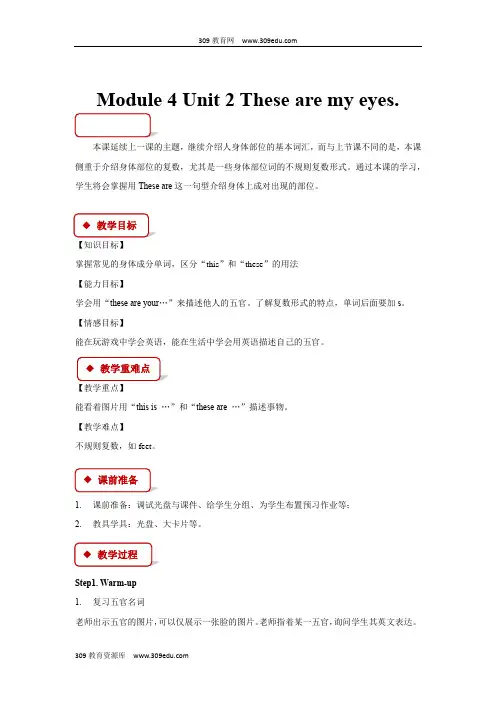
Module 4 Unit 2 These are my eyes.本课延续上一课的主题,继续介绍人身体部位的基本词汇,而与上节课不同的是,本课侧重于介绍身体部位的复数,尤其是一些身体部位词的不规则复数形式。
通过本课的学习,学生将会掌握用These are这一句型介绍身体上成对出现的部位。
【知识目标】掌握常见的身体成分单词,区分“this”和“these”的用法【能力目标】学会用“these are your…”来描述他人的五官。
了解复数形式的特点,单词后面要加s。
【情感目标】能在玩游戏中学会英语,能在生活中学会用英语描述自己的五官。
【教学重点】能看着图片用“this is …”和“these are …”描述事物。
【教学难点】不规则复数,如feet。
1. 课前准备:调试光盘与课件、给学生分组、为学生布置预习作业等;2. 教具学具:光盘、大卡片等。
Step1. Warm-up1. 复习五官名词老师出示五官的图片,可以仅展示一张脸的图片。
老师指着某一五官,询问学生其英文表达。
T: What’s this?T: This is the ear.2. 复习hand老师展示自己的双手,并鼓励学生模仿。
T: These are my hands. (老师展示双手)老师指出These are可以用来介绍数目大于一个的器官,而this is只能介绍一个器官。
3. 学习leg老师展示人腿部的照片,引入leg和legs。
T: These are legs。
4. 学习foot老师展示人足部的照片,引入foot和feet。
T: This is a foot. These are two feet.老师指出feet是foot的复数,请学生牢记。
5.游戏:听词做动作。
老师规定,说hands,大家就拍拍手;说legs,大家就敲敲腿;说foot,就跺一只脚,说feet 就跺两只脚。
通过游戏帮助学生记忆。
5. 学习spider老师展示清晰的蜘蛛照片,引入spider。
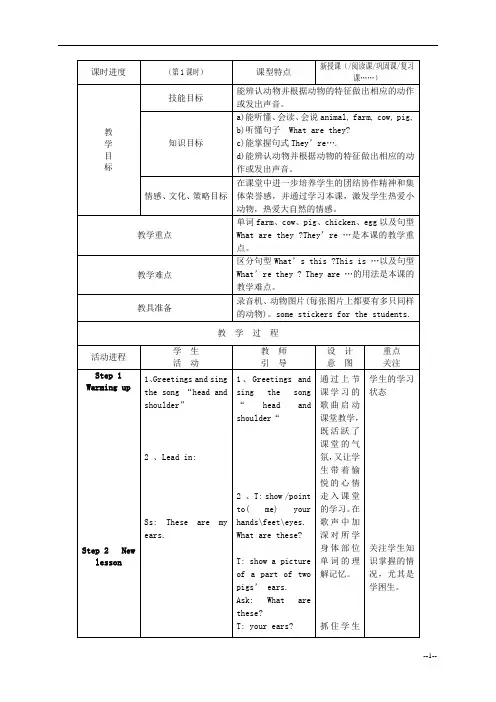
课时进度(第1课时)课型特点新授课(/阅读课/巩固课/复习课……)教学目标技能目标能辨认动物并根据动物的特征做出相应的动作或发出声音。
知识目标a)能听懂、会读、会说animal, farm, cow, pig,b)听懂句子 What are they?c)能掌握句式They’re….d)能辨认动物并根据动物的特征做出相应的动作或发出声音。
情感、文化、策略目标在课堂中进一步培养学生的团结协作精神和集体荣誉感,并通过学习本课,激发学生热爱小动物,热爱大自然的情感。
教学重点单词farm、cow、pig、chicken、egg以及句型What are they ?They’re …是本课的教学重点。
教学难点区分句型What’s this ?This is …以及句型What’re they ? They are …的用法是本课的教学难点。
教具准备录音机、动物图片(每张图片上都要有多只同样的动物)。
some stickers for the students.教学过程活动进程学生活动教师引导设计意图重点关注Step 1 Warming upStep 2 New lesson 1、Greetings and singthe song “head andshoulder”2 、Lead in:Ss: These are myears.1、Greetings andsing the song“head andshoulder“2 、T: show /pointto( me) yourhands\feet\eyes.What are these?T: show a pictureof a part of twopigs’ ears.Ask: What arethese?T: your ears?通过上节课学习的歌曲启动课堂教学,既活跃了课堂的气氛,又让学生带着愉悦的心情走入课堂的学习。
在歌声中加深对所学身体部位单词的理解记忆。
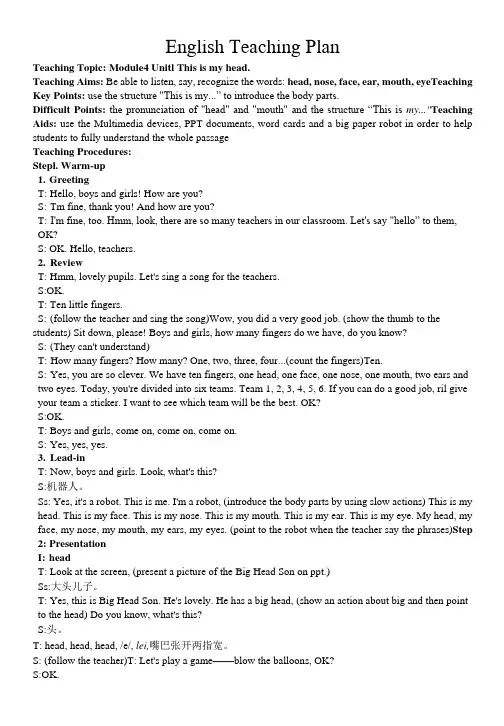
English Teaching PlanTeaching Topic: Module4 Unitl This is my head.Teaching Aims: Be able to listen, say, recognize the words: head, nose, face, ear, mouth, eyeTeaching Key Points: use the structure "This is my...” to introduce the body parts.Difficult Points: the pronunciation of "head" and "mouth" and the structure “This is my..."Teaching Aids: use the Multimedia devices, PPT documents, word cards and a big paper robot in order to help students to fully understand the whole passageTeaching Procedures:Stepl. Warm-up1.GreetingT: Hello, boys and girls! How are you?S:Tm fine, thank you! And how are you?T:I'm fine, too. Hmm, look, there are so many teachers in our classroom. Let's say "hello” to them, OK?S: OK. Hello, teachers.2.ReviewT: Hmm, lovely pupils. Let's sing a song for the teachers.S:OK.T: Ten little fingers.S:(follow the teacher and sing the song)Wow, you did a very good job. (show the thumb to the students) Sit down, please! Boys and girls, how many fingers do we have, do you know?S:(They can't understand)T:How many fingers? How many? One, two, three, four...(count the fingers)Ten.S:Yes, you are so clever. We have ten fingers, one head, one face, one nose, one mouth, two ears and two eyes. Today, you're divided into six teams. Team 1, 2, 3, 4, 5, 6. If you can do a good job, ril give your team a sticker. I want to see which team will be the best. OK?S:OK.T: Boys and girls, come on, come on, come on.S:Yes, yes, yes.3.Lead-inT:Now, boys and girls. Look, what's this?S:机器人。
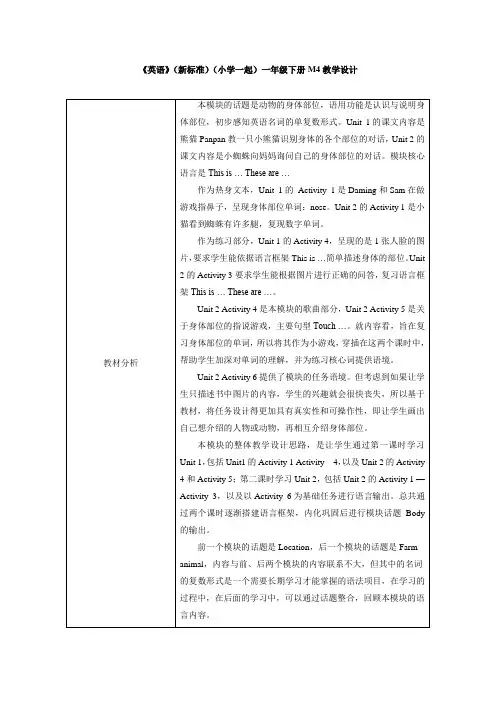
《英语》(新标准)(小学一起)一年级下册M4教学设计Step 2: Presentation(15 minutes) 1. Show the pictureof Activity 1 in Unit1. Ask Ss to touchtheir noses. Thenask them to listenand say.2. Play a game: LetSs point at or touchtheir body parts.e.g.:Touch your eye.Touch your mouth.3. Show the firstpicture of Activity2. Ask the students:What can you see inthis picture?4. T: Yes. They arePanpan and babypanda. What isPanpan teaching thebaby panda?1. Look, listen and do.2. Listen and do.3. Look and say.S1: Two pandas.4. Watch the CD-ROMof Activity 2. Then saythe body parts: head,face, nose, ear, mouth,eye, body简单地描述图意后,让学生边听边做,而后让学生看视频。
既通过游戏培养学生学习兴趣,又通过文本再一次巩固歌曲中的单词,为核心语言在文本中的学习作好铺垫。
通过文本第一幅图,导出本文主题,感知本课语境。
通过第一遍看文本视频,关注教师的问题,学习重点词。
本课核心语句通过第一遍播放视频得以呈现。
Watch and introduce the body parts.Teach the words.5. Look and say (Show the pictures about the dialogue). Introduce the body parts. Then stick the key words and sentences on the blackboard. 5. According to thepictures, talk about thebody parts.Such as:This is my...This is your…Sum up the keystructures.通过第二遍看文本,教师和学生一起建构小熊猫身体部位的信息图,在此过程中,帮助学生梳理信息。
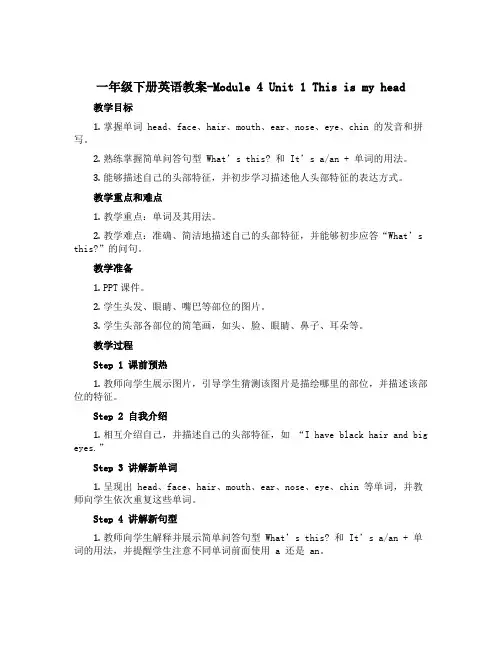
一年级下册英语教案-Module 4 Unit 1 This is my head
教学目标
1.掌握单词 head、face、hair、mouth、ear、nose、eye、chin 的发音和拼写。
2.熟练掌握简单问答句型What’s this? 和It’s a/an + 单词的用法。
3.能够描述自己的头部特征,并初步学习描述他人头部特征的表达方式。
教学重点和难点
1.教学重点:单词及其用法。
2.教学难点:准确、简洁地描述自己的头部特征,并能够初步应答“What’s this?”的问句。
教学准备
1.PPT课件。
2.学生头发、眼睛、嘴巴等部位的图片。
3.学生头部各部位的简笔画,如头、脸、眼睛、鼻子、耳朵等。
教学过程
Step 1 课前预热
1.教师向学生展示图片,引导学生猜测该图片是描绘哪里的部位,并描述该部位的特征。
Step 2 自我介绍
1.相互介绍自己,并描述自己的头部特征,如“I have black hair and big eyes.”
Step 3 讲解新单词
1.呈现出 head、face、hair、mouth、ear、nose、eye、chin 等单词,并教师向学生依次重复这些单词。
Step 4 讲解新句型
1.教师向学生解释并展示简单问答句型What’s this? 和It’s a/an + 单词的用法,并提醒学生注意不同单词前面使用 a 还是 an。
Step 5 学习表达方式
1.以头部各部位为例,学生首先在独立单元中完成简笔画,在教师的引导下学习正确的表达方式。
如。
一年级下英语教案Module 4外研版(一起)教学目标1. 让学生掌握Module 4中的核心词汇和句型,如“classmate”,“friend”,“play together”等。
2. 培养学生的听说能力和团队合作能力。
3. 通过学习,让学生了解和尊重不同文化背景的同学。
教学内容1. 核心词汇:classmate,friend,play,together等。
2. 核心句型:Hello, I'm ; This is my classmate/friend ;We play together.教学重点与难点1. 教学重点:掌握核心词汇和句型,能够运用到实际情境中。
2. 教学难点:正确运用“classmate”和“friend”,理解“play together”的含义。
教具与学具准备1. 教具:PPT,教学卡片,录音机,磁带。
2. 学具:英语课本,练习册,彩色笔。
教学过程1. 导入:通过播放英文歌曲,让学生进入英语学习状态。
2. 新课内容展示:通过PPT展示新课的核心词汇和句型,让学生跟读并模仿。
3. 情境练习:设置不同的情境,让学生运用所学词汇和句型进行练习。
4. 小组活动:学生分组进行角色扮演,模拟真实情境进行对话练习。
板书设计1. 核心词汇:classmate,friend,play,together等。
2. 核心句型:Hello, I'm ; This is my classmate/friend ;We play together.作业设计1. 听力练习:听录音,选择正确的图片。
2. 口语练习:和同学进行角色扮演,模拟真实情境进行对话。
3. 写作练习:用英语写一段自我介绍,包括自己的名字,班级和好朋友。
课后反思通过本次教学,我发现学生在掌握核心词汇和句型方面表现良好,但在实际运用中还存在一些问题。
例如,有些学生在运用“classmate”和“friend”时容易混淆,有些学生对“play together”的含义理解不够深入。
外研版(一起)一年级英语下册教案Module4 Unit 1 This ismy head.一、教学目标1. 知识与技能:学生能够听懂、会说、会读本课的单词:head, ear, eye, nose, mouth, face。
学生能够听懂、会说、会读本课的句子:This is my head/ear/eye/nose/mouth/face。
2. 过程与方法:通过图片、实物展示,让学生直观地学习身体部位的单词和句子。
通过游戏、歌曲等形式,让学生在轻松愉快的氛围中巩固所学知识。
3. 情感态度与价值观:培养学生爱护自己的身体,关注自己的身体健康。
培养学生积极参与、乐于合作的良好学习习惯。
二、教学内容1. 单词:head, ear, eye, nose, mouth, face2. 句子:This is my head/ear/eye/nose/mouth/face三、教学重点与难点1. 教学重点:学生能够正确掌握单词head, ear, eye, nose, mouth, face的发音和拼写。
学生能够正确运用句子This is myhead/ear/eye/nose/mouth/face描述自己的身体部位。
2. 教学难点:学生能够区分和运用不同身体部位的单词。
学生能够流利地朗读和运用本课的句子。
四、教具与学具准备1. 教具:PPT、单词卡片、实物模型、录音机、磁带2. 学具:学生用书、练习册、彩笔、剪刀、胶水五、教学过程1. 热身活动:唱英文歌曲,让学生在轻松愉快的氛围中进入课堂。
2. 新课导入:通过展示实物模型,让学生直观地认识身体部位,引导学生学习单词head, ear, eye, nose, mouth, face。
3. 课堂讲解:通过PPT展示单词和句子,让学生跟读并模仿发音,讲解句子的结构和用法。
4. 实践活动:分组进行角色扮演,让学生运用所学单词和句子描述自己的身体部位。
5. 巩固练习:通过练习册、游戏等形式,让学生巩固所学知识。
小学英语外研版一起一年级下册Unit 1 This is I my head.一 教学内容第一课时 新标准英语第二册Module4 Unit1 This is my head.二 教学目标能听懂,会读,会说并能灵活运用单词。
head ,face ,nose ,mouth ,ear ,eye三 教学重点和难点单词的教授,单词的发音以及单词的熟练运用。
四 教具准备课件,图片,单词卡片五 教学过程Step 1 Warming-upGreeting:T: Good morning, boys and girls!S: Good morning, Miss Ding!Step 2 Revision播放课件T: Now look at the screen, what can you see? What’s this? 课件中先快速闪烁几种职业的人:nurse, teacher, doctor, driver让学生猜并回答S: She/he is a…然后再快速闪烁几种有上面职业特征的物品: bus, dress,coat, bag让学生猜并回答S: This is her/his…然后让学生把两句话连起来说.Step 3 Presentation⑴T: OK, very good! What’s this?在一个学生头上贴上一朵小花)S: It's a flower (问其他学生)Where's the flower?T: (问其他学生S: 在某某某头上引出headafter the teacher.picture) Read the word "head"(Show aTeacher must emphasize the pronunciation. Use team work or让学生边说边touch their head.group work to practice .⑵T: (Take out a star) What's this?S: ……xKb 1.C om在一个学生的脸上贴上一个小星星)T: Give you a star. (T: Where's the star now?S: 在某某某的脸上.引出faceShow a picture face .Read the word face after the teacher.Teacher must emphasize the pronunciation. Use team work or让学生边说边touch their facegroup work to practice .⑶T: There are some organs in our head, what are they?S: ……引出mouth, eye, ear, noseShow the picture eyeT: what's this?S: ……Read the word eye after the teacher. Teacher must emphasize the pronunciation. Use team work or group work to 让学生边说边touch their eye. 新 课 标 第 一 网practice .让学生边说边⑷Show the picture noseT: What's this?S: ……Read the word nose after the teacher .Teacher must emphasize the pronunciation. Use team work or group work to 让学生边说边touch their nose.practice .让学生边说边⑸Show a picture mouthT: What's this?S: ……Read the word mouth after the teacher. Teacher must emphasize the pronunciation. Use team work or group work to 让学生边说边touch their mouth.practice .让学生边说边⑹Show a picture earT: What's this?S: ……Read the word ear after the teacher. Teacher must emphasize the pronunciation. Use team work or group work to practice .让学生边说边让学生边说边touch their ear.Step 4 Practices and Consolidation1、拿出图片让学生说出单词,然后让学生把单词贴到相应图片下面.T: Put the words to the right picture. I will ask a boy and a girl.比一比谁贴得又对又快.2、为小动物找丢失的鼻子,眼睛,嘴巴,耳朵,并帮助他们贴上。
一年级下英语教案Module 4 Unit 1 This is my head外研社(一起)教学目标本节课旨在让学生能够识别并描述自己的身体部位,包括头部、脸部、眼睛、鼻子、嘴巴和耳朵。
通过本节课的学习,学生能够用英语进行简单的自我介绍,并能够理解并运用本节课的重点句型"Thisis my head/face/eye/nose/mouth/ear"。
教学内容本节课主要学习身体部位的单词和句型,包括head、face、eye、nose、mouth和ear,以及句型"This is myhead/face/eye/nose/mouth/ear"。
教学重点与难点教学重点是让学生掌握身体部位的单词和句型,能够用英语进行简单的自我介绍。
教学难点是让学生正确理解和运用句型"This is my head/face/eye/nose/mouth/ear",并能够准确地描述自己的身体部位。
教具与学具准备教具包括多媒体课件、图片、卡片等。
学具包括学生自己的身体部位、纸和笔等。
教学过程1. 导入:通过唱英文歌曲或做游戏等方式引起学生的兴趣,让学生进入学习状态。
2. 新课导入:通过图片或实物展示,引导学生学习身体部位的单词和句型。
3. 练习:通过游戏、角色扮演等活动,让学生练习使用身体部位的单词和句型。
4. 应用:通过让学生自己描述自己的身体部位,巩固所学知识。
板书设计板书设计应简洁明了,突出本节课的重点内容。
可以采用图示和文字相结合的方式,展示身体部位的单词和句型。
作业设计作业设计应与课堂教学内容相结合,包括书面作业和口头作业。
书面作业可以包括填空、选择、翻译等,口头作业可以包括角色扮演、自我介绍等。
课后反思课后反思应包括对教学效果的评价和对教学方法的改进。
教师可以根据学生的反馈和学习情况,及时调整教学策略,提高教学效果。
重点关注的细节是教学过程。
教学过程是整个教案中最为重要的部分,它直接影响到学生的学习效果和教学目标的实现。
Module 4(教学设计)外研版(一起)英语一年级下册课程目标本节课的主要目标是:•学习关于日常生活中的常见食物和饮料的词汇;•学习如何用英语描述食物和饮料的口感、颜色和形状;•学习如何用英语询问和回答有关食物和饮料的问题。
同时,这节课也旨在提高学生的听、说、读、写能力,增强学生对英语学习的兴趣。
课前准备在上课之前,老师应该准备好以下教学材料:•PPT幻灯片或白板;•纸张和笔;•视频或音频素材同时,为了让学生更好地参与到课堂中来,老师还要为他们准备一些实物,例如:•水果和蔬菜;•奶酪、面包和饼干;•奶茶、果汁和牛奶。
课堂教学流程学生出示实物,导入新词汇1.学生出示实物,并说出它们的名称,例如:apple、banana、juice等。
2.老师出示幻灯片或图片,将每个实物的名称写在幻灯片上,并称它们为“food and drink”。
观察图片,学习新的形容词1.老师将图片显示在幻灯片上,引导学生观察图片。
2.老师用绿色笔勾画食物和饮品的形状,并用黑色笔标注它们的颜色和口感,例如:“The apple is round and red. It’s sweet and juicy.”3.老师教授一些形容词,例如:sweet、sour、bitter、spicy、juicy、crispy、soft、hard等,并运用这些词汇来描述实物。
观看视频,学习新的句型1.老师播放视频,让学生通过听觉感知词汇的发音和句子的构成。
2.视频中的句型:What do you like? I like…,老师解释句子的含义,并让学生齐读几遍。
3.老师给出一些问题,例如:“What do you like?Do you like apples?”,引导学生用英文回答,并将问题和回答写在黑板上。
情景模拟,进行口语练习1.老师要求学生分成小组,各自担任不同角色,例如:顾客、服务员等等,情景模拟进行口语练习。
2.学生之间进行对话,并用所学到的词汇进行交流,例如:“Can I have a glass of juice, please? What kind of juice do you like?”小结,巩固所学内容1.老师提出一些问题,例如:“What did we learn today?What do youlike to eat?”2.学生回答问题,并用所学到的词汇进行描述。
一年级英语下册-Module-4-Unit-1(1)说课稿-外研版(一起)外研版(一起)一年级英语下册说课稿Module 4Unit 1 This is my head.一、说教材本课是《新标准英语》第二册第四模块第一单元,本模块主要是通过熊猫的身体器官来学习人体器官。
但是要注意单复数的区别和使用。
而对于一年级的学生而言,单复数已然是比较难和重要的语法项目了,同时也要区分these 和this之间的区别和运用,能够正确使用本语法与单词。
从素质教育的要求和学习语言的目的看,本课主要通过情境教学,使学生潜移默化地掌握人体器官,了解单复数形式,使学生能够在准确的情境下运用。
1. 教学目标的确立及其依据知识目标:学习人体器官单词:nose, head, ear, eye, mouth, face.句型:This is my…This is your…能力目标:通过TPR和游戏的形式掌握单词与句型,认识与表达自己器官的能力。
情感态度:通过学习人体器官,培养学生爱惜自己的身体。
2. 学情分析我本课所讲的是新标准英语一年级起点第二册第四模块第一单元,这是一篇关于人体器官学习的教学内容,此内容通过熊猫之间的对话让学生学会描述自己的人体器官,本课与学生们的生活息息相关,从学生的身边入手去了解和记忆,同时在同桌间互相介绍,用TPR的形式帮助记忆,通过游戏加以巩固练习,使学生在快乐的学习气氛中掌握人体器官的名称。
3. 说重点、难点及关键点的确立及依据本课的重点、难点及关键点都是人体器官的学习和单复数的区别和运用,在教授单词之后,要通过适当的情境,以学生们本身的指引,潜移默化地渗透单复数。
是否一次性的教授到位对学生至关重要,因此要做好课前准备,注意语言简洁准确。
在人体器官的学习过程中,通过歌曲帮助学生学习更多的人体器官,并在歌曲中更加巩固知识。
但要注意单词mouth的发音。
二、说教法与学法根据教材特点和配合学生年龄特点,运用多媒体教学手段创设具体、生动的画面,使学生通过动画来理解课文,并通过多种形式,让学生在轻松愉快的环境中接受知识,教学过程中,创设愉悦和谐的情感氛围,发挥学生的主体,教师的指导作用,以求成功完成教学目标。